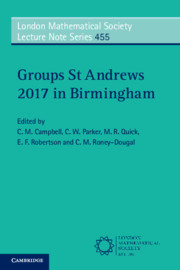Book contents
- Frontmatter
- Contents
- Introduction
- Finite Simple Groups and Fusion Systems
- Finite and Infinite Quotients of Discrete and Indiscrete Groups
- Local-Global Conjectures and Blocks of Simple Groups
- A Survey on Some Methods of Generating Finite Simple Groups
- One-Relator Groups: An Overview
- New Progress in Products of Conjugacy Classes in Finite Groups
- Aspherical Relative Presentations all Over Again
- Simple Groups, Generation and Probabilistic Methods
- Irreducible Subgroups of Simple Algebraic Groups – A Survey
- Practical Computation with Linear Groups Over Infinite Domains
- Beauville p-Groups: A Survey
- Structural Criteria in Factorised Groups Via Conjugacy Class Sizes
- Growth in Linear Algebraic Groups and Permutation Groups: Towards a Unified Perspective
- L2-Betti Numbers and their Analogues in Positive Characteristic
- On the Pronormality of Subgroups of Odd Index in Finite Simple Groups
- Vertex Stabilizers of Graphs with Primitive Automorphism Groups and a Strong Version of the Sims Conjecture
- On the Character Degrees of a Sylow p-Subgroup of a Finite Chevalley Group G(pf) Over a Bad Prime
- Patterns on Symmetric Riemann Surfaces
- Subgroups of Twisted Wreath Products
- Some Remarks on Self-Dual Codes Invariant Under Almost Simple Permutation Groups
- Test Elements: From Pro-p to Discrete Groups
- References
Simple Groups, Generation and Probabilistic Methods
Published online by Cambridge University Press: 15 April 2019
- Frontmatter
- Contents
- Introduction
- Finite Simple Groups and Fusion Systems
- Finite and Infinite Quotients of Discrete and Indiscrete Groups
- Local-Global Conjectures and Blocks of Simple Groups
- A Survey on Some Methods of Generating Finite Simple Groups
- One-Relator Groups: An Overview
- New Progress in Products of Conjugacy Classes in Finite Groups
- Aspherical Relative Presentations all Over Again
- Simple Groups, Generation and Probabilistic Methods
- Irreducible Subgroups of Simple Algebraic Groups – A Survey
- Practical Computation with Linear Groups Over Infinite Domains
- Beauville p-Groups: A Survey
- Structural Criteria in Factorised Groups Via Conjugacy Class Sizes
- Growth in Linear Algebraic Groups and Permutation Groups: Towards a Unified Perspective
- L2-Betti Numbers and their Analogues in Positive Characteristic
- On the Pronormality of Subgroups of Odd Index in Finite Simple Groups
- Vertex Stabilizers of Graphs with Primitive Automorphism Groups and a Strong Version of the Sims Conjecture
- On the Character Degrees of a Sylow p-Subgroup of a Finite Chevalley Group G(pf) Over a Bad Prime
- Patterns on Symmetric Riemann Surfaces
- Subgroups of Twisted Wreath Products
- Some Remarks on Self-Dual Codes Invariant Under Almost Simple Permutation Groups
- Test Elements: From Pro-p to Discrete Groups
- References
Summary
It is well known that every finite simple group can be generated by two elements and this leads to a wide range of problems that have been the focus of intensive research in recent years. In this survey article we discuss some of the extraordinary generation properties of simple groups, focussing on topics such as random generation, (a, b)-generation and spread, as well as highlighting the application of probabilistic methods in the proofs of many of the main results. We also present some recent work on the minimal generation of maximal and second maximal subgroups of simple groups, which has applications to the study of subgroup growth and the generation of primitive permutation groups.
- Type
- Chapter
- Information
- Groups St Andrews 2017 in Birmingham , pp. 200 - 229Publisher: Cambridge University PressPrint publication year: 2019
References
- 5
- Cited by



